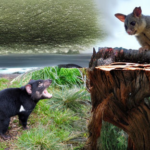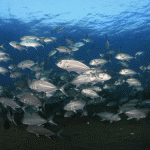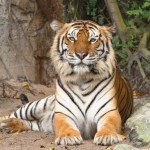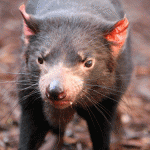
Australia's own sea turtle. Image: Biosphere Expeditions
We didn’t have to walk much during that hot November evening. We packed our dinner, climbed into a Land Rover and drove to Yardoogarra Creek, locally known as Jack’s Creek. When we got there, I started feeling anxious. I had camped before, but this was my first time on the beach and I was scared of the predators that might be lurking in the darkness. My eyes were fixed on the mangroves; if something moved, I was ready to run for my precious life. But Kerry Hardly, research assistant for Conservation Volunteers Australia (CVA), soothed my fears.
After setting up our tents, we sat down to enjoy the sunset. I needed to rest for a few minutes before embarking on that night’s mission. The night before I walked 7.5 kilometres trying to identify a female Flatback turtle (Natator depressus) and my calves were sore. It was pitch-dark and to my untrained eyes everything looked like a turtle, including rocks and sponges. In less than 48 hours, the Flatback had become my personal Moby Dick.
During the 2010 nesting season, researchers and volunteers from CVA and Biosphere Expeditions registered 17 nests and 73 false crawls in the 3.5-kilometre area that comprises Jack’s Creek. With those numbers in mind, we all wondered if this would be the night we came face to face with one of these prehistoric-looking creatures. If we saw a turtle, Erin McCloskey, assistant expedition leader for Biosphere Expeditions, would restrain her; Deborah, a volunteer who joined the team via Biosphere Expeditions, would take notes, and I would measure her. “So, I guess we’ll start five minutes earlier,” said Kerry. We stood up, grabbed our rucksacks and… “Is that a turtle?” asked Deborah.
And there it was, a majestic Flatback crawling towards the dry sand to dig up a nest. Kerry explained the process as we lay motionless and admired from afar how the turtle crawled toward our tents, leaving a consistent track in the sand that we would measure later on.
It took the turtle more than half an hour and a lot of flipper action to find the right place for her nest. It was dark, but our eyes had somehow adjusted to the pristine moonlight. We could conjure up her life story, as marks of previous matings and some barnacles adorned her greyish carapace.
Turtles on the brink
Flatback turtles are endemic to Australia, and they are currently listed as Data Deficient in the International Union for Conservation (IUCN) Red List of Threatened Species. In 2010, the Eco Beach Sea Turtle Monitoring Program, managed by CVA and supported by Biosphere Expeditions, reported the sighting of 42 female turtles in the 12-kilometre survey area that goes from Eco Beach Resort to Jack’s Creek.
There are eight known species of sea turtles; six of them inhabit Australian waters. The Environment Protection and Biodiversity Conservation Act 1999 (EPBC) protects the six of them. Leatherback (Dermochelys coriacea), Loggerhead (Caretta caretta) and Olive Ridley (Lepidochelys olivacea) are listed as endangered under the EPBC; Flatback (Natator depressus), Hawksbill (Eretmochelys imbricata) and Green (Chelonia mydas) are listed as vulnerable.
Flatbacks are carnivorous; they feed on sea cucumbers, crustaceans and invertebrates. Some of them have died after eating plastic bags — which resemble jellyfish — others have been victims of fishermen’s nets. Poachers are also responsible for their decline.
Little is known of the Flatback’s lifecycle after its hatchling period, as juvenile specimens rarely reach the shores. In the 1880s, zoologist Samuel Garman described them as a relative of the Green turtle; it wasn’t until 1988, following years of research by Colin Limpus and his research team at Queensland Parks and Wildlife Services, that Australia’s own sea turtle was recognised as a separate species.
Flatbacks swim up to 1,300 kilometres between feeding grounds in Indonesia and Western Australia, and reach sexual maturity at age 25-50. When the females are ready to lay their eggs, they leave their natural habitat for up to three hours, exposing themselves to all sorts of perils. It is in these dark, dry and strange surroundings that each female Flatback guarantees the survival of the species.
A never-ending choreography
All the flipper action ceased. Our turtle lay still, breathing heavily, her carapace moving up and down. It was then that her rear flippers sprang into action, transformed into a sophisticated digging mechanism that ensures the correct length and width of the egg chamber — and their every move seemed choreographed. First she would point one of the hind flippers, moving it towards the egg chamber to measure the depth; then, on the way up, the flipper would curve and function as a digging machine to remove excess sand. The dance continued until the egg chamber was deep enough (approximately 45 centimetres) to receive the eggs.
Erin counted each golf-ball-sized egg. Our turtle laid more than 40 eggs in less than 20 minutes — her eyes were covered in tears. And then she stopped.
With renewed energy, our turtle used her hind flippers to cover the clutch. I was recording that process, and from the camera’s viewfinder her flippers resembled a pair of motherly hands gently patting the sand. It took her about four minutes to cover the egg chamber. Then our turtle started moving her entire body, her four flippers working hard to camouflage the nest. The tears — excess salt produced by a modified tear gland — stopped flowing.
While she was camouflaging the nest, we prepared for the tagging process. Kerry handed me a cotton ball soaked in Betadine, as well as one titanium tag and pliers. Once the turtle started crawling down toward the sea, Kerry and Erin intercepted her. Erin tried to hold her; Deborah and I knelt next to Kerry. I handed the Betadine to Kerry, she cleaned the right front flipper, grabbed the pliers and inserted the tag with one quick motion — a process that somehow reminded me of earlobe piercing. I approached the female turtle, the carapace was bigger than I expected, almost 90 centimetres in length and 75 in width. In the meantime, Erin was caressing the turtle’s neck; the gentle strokes seemed to calm her.
After taking a DNA sample and making sure that our turtle was healthy and uninjured, Erin released her. Watching her disappear into the vastness of the ocean was one of the most rewarding experiences I’ve ever had. For the first time in my life, I had done something tangible to help save an endangered species. Less than two kilometres away, we identified another turtle.
Minority report
Each titanium tag has two pieces of information, the letters WA (Western Australia) and a serial number. These are recorded and entered into a database that allows researchers to track and compare remigrant patterns. According to the results published by the Eco Beach Sea Turtle Monitoring Program, Flatback turtles nest at two-year intervals (15-30 per cent of WA Flatbacks have a remigrant interval of one year; 14 turtles from 2009 returned in 2010 to lay their eggs in the same beach).
Our second turtle was a neophyte, as she had no previous tagging scars. She seemed younger; her carapace didn’t have as many mating scars and there were no barnacles. She was also smaller, less than 85 centimetres long. But she was feisty; restraining her wasn’t easy. That’s why I had to hand the pliers and tags to Deborah and help Erin. “It’s going to be alright,” I said. When I finished measuring, we let her go. The full moon illuminated the scene, the turtle’s carapace shone in the darkness like a silver coin. When she reached the sea, we saw her for the last time. Then we turned around, registered the nest coordinates and measured her tracks.
Covered in sand and thirsty we headed back to the tents. We were sweaty and tired and didn’t realise it was one in the morning. I couldn’t sleep; I just kept replaying the scenes in my mind. I had conquered my Moby Dick and was ready to face the next five days of the expedition.
The 2011 turtle-monitoring program started on November 7 and ended on the 16th of December, 2011. I spent one week at Eco Beach Resort working with Biosphere Expeditions (biosphere-expeditions.org). During that period, we registered 10 nests, eight false crawls and five turtles. The number of sightings increased as November unfolded. The hatchlings of the first turtle my team saw were born between December 22 and 23. In 25-30 years, some of them will return to Jack’s Creek to lay their own eggs.
This story was published in the January/February 2012 edition of Science Illustrated. If you want to learn more about Biosphere Expeditions click here.






